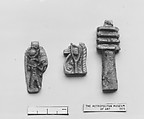Wedjat Eye Amulet
Third Intermediate Period
This wedjat eye amulet was found on the left arm of the mummy together with a Thoth amulet and a djed pillar amulet (see 25.3.170a, b). Amulets were thought to magically transfer their power to the wearer. Such power often derived from their shape, material, color, and/or the recitations spoken over them. One of the most popular amulets in ancient Egypt, the wedjat eye represents the healed eye of the god Horus. It depicts a combination of a human and a falcon eye, since Horus was often associated with a falcon. Its ancient Egyptian name, wedjat, means "the one that is sound (again)." In Egyptian mythology Horus’ eye was injured or stolen by the god Seth and then restored by Thoth. The wedjat eye embodies healing power and symbolizes rebirth. An amulet in this shape was thought to protect its wearer and to transfer the power of regeneration onto him or her. It was used by the living as well as for the dead.
Due to rights restrictions, this image cannot be enlarged, viewed at full screen, or downloaded.

